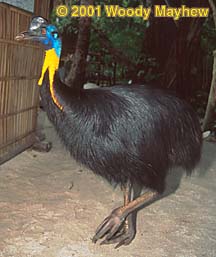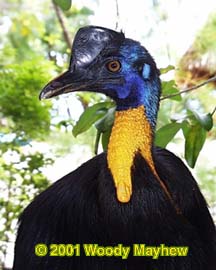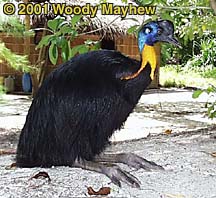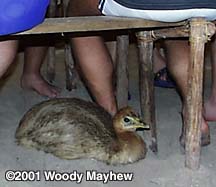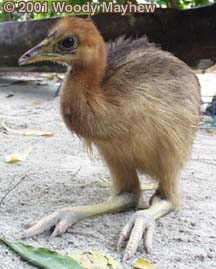Irian Jaya Cassowary Gallery | 
|
The Cassowary is a large, flightless bird native to the Australia-New Guinea area. The Cassowary is smaller than the ostrich and emu, reaching a height of five feet and over 100 lbs. They are nimble, fast birds that can run up to 30 mph. They are also good swimmers and will often venture into the water, even off the beach into the ocean. These birds are the Northern Cassowary, Casuarias Unappendiculatus, native to New Guinea Island and smaller than the better known Southern Cassowary of Australia. The Northern Cassowary does not have the distinctive twin red neck wattles of the Southern Cassowary.
Cassowaries can be dangerous, even deadly, in confrontations with man. They have powerful legs and their three-toed feet are used as formidable weapons.
The name Cassowary comes from the Papuan words Kasu Weri, meaning 'horned head', which refers to the horn cap or Casque on the head of both sexes of the Cassowary. The Casque is formed of cartilage and covered with a thn layer of keratin, a covering similar to our fingernails. The casque protects the bird's head while moving through the tangled forest and digging in the ground for food items.
The female makes a shallow debris pile nest on the forest floor and lays a clutch of from three to five eggs. This sitting position is used by the male while incubating the eggs after the female lays them. The male incubates the eggs for more than a month and a half, staying on the nest until they hatch. He then cares for the chicks until they are old enough to fend for themselves at the age of approximately seven months. The males are very protective of the chicks until they are old enough to go off on their own. This bird is simply resting.
The chicks have dark stripes at hatching and the stripes fade until the chick reaches sub-adulthood and becomes a solid light brown color. The stripes are still discernable on this chick, so it is almost at the sub-adult stage of approximately seven months of age.
This chick was happy to come into the cook house and lay under the benches at the dinner table at our feet, occasionally making soft, contented cheeping sounds. Interestingly, this chick was naturally housebroken, getting up and going outside to defecate and then returning inside and resuming its position under the table at our feet.
The chick can sit with its body off the ground, or with its body fully on the ground with its legs beneath it, or even sleep on its side with its legs outstretched from its body, much as a dog might. The beginning of the Casque development can be seen on the chick's head at this subadult stage.
These free-roaming birds were photographed at the Irian Diving camps in the Rajah Empat Islands of Irian Jaya (a boat ride west of the mainland city of Sorong), Indonesia in October 2000 and November, 2001.All Photos on this page © 2001,Woody Mayhew
